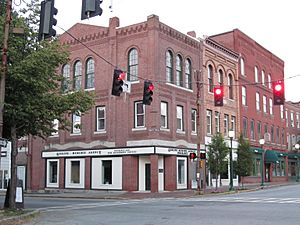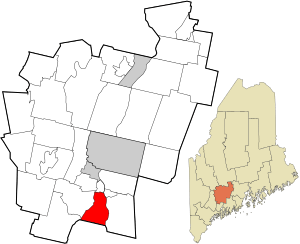Gardiner, Maine facts for kids
Quick facts for kids
Gardiner, Maine
|
||
|---|---|---|

|
||
|
||
| Motto(s):
Moving Forward
|
||

Location in Kennebec County and the state of Maine.
|
||
| Country | United States | |
| State | Maine | |
| County | Kennebec | |
| Incorporated | February 17, 1803 | |
| Villages | Libby Hill South Gardiner |
|
| Government | ||
| • Type | Mayor and council-manager | |
| Area | ||
| • Total | 16.57 sq mi (42.91 km2) | |
| • Land | 15.68 sq mi (40.61 km2) | |
| • Water | 0.89 sq mi (2.30 km2) | |
| Elevation | 30 ft (9 m) | |
| Population
(2020)
|
||
| • Total | 5,961 | |
| • Density | 380.14/sq mi (146.77/km2) | |
| Time zone | UTC−5 (Eastern (EST)) | |
| • Summer (DST) | UTC−4 (EDT) | |
| ZIP Codes |
04345 (Gardiner)
04359 (South Gardiner) |
|
| Area code(s) | 207 | |
| FIPS code | 23-27085 | |
| GNIS feature ID | 0566690 | |
Gardiner is a city in Kennebec County, Maine, United States. About 5,961 people lived there in 2020. Gardiner is a popular place for visitors. It is known for its interesting culture and beautiful old buildings. The city is part of the larger Augusta area.
Contents
Discovering Gardiner's Past: A Journey Through Time
Gardiner was founded in 1754 by a doctor named Silvester Gardiner. He named it Gardinerstown Plantation. Dr. Gardiner was a wealthy doctor from Boston. He owned a lot of land in the area.
How Gardiner Grew: Early Settlements and Mills
Dr. Gardiner wanted his new settlement to grow. He brought in people who could build mills and houses. These included a gristmill builder, a saw millwright, and a carpenter. Houses, mills, a church, and a blockhouse were built.
The city is located where the Kennebec River meets Cobbesseecontee Stream. This stream has waterfalls that drop 130 feet. This made it a perfect spot for water-powered mills. Gardinerstown quickly became important for the region's economy.
From Plantation to City: Trade and Industry
During the American Revolutionary War, Dr. Gardiner left because he supported the British. But his settlement kept growing. In 1803, it officially became the town of Gardiner.
In the early 1800s, shipbuilding and trade were very important. Gardiner became a city in 1849. At that time, it had ten large wharves along the river. These were used for shipping goods. A lot of Lumber was shipped from Gardiner. Factories that made leather and shoes also did well.
The Famous Ice Trade: A Cool Business
Gardiner became famous around the world for exporting ice. Every winter, workers cut huge blocks of ice from the Kennebec River. They stored the ice in warehouses and covered it with sawdust. This kept the ice frozen even in summer.
Large ships carried this ice to other parts of the United States and the world. Gardiner's ice was known for being very clean. It was cut from the river at the furthest point ships could reach.
Modern Gardiner: From Mills to Community
In 1851, a railroad connected Gardiner to other places. In 1858, one of the first working steam cars in America was built here. Paper mills also became important in the 1860s. The ice business thrived from the 1880s to the 1920s.
However, by the 1960s, many mills closed down. Today, Gardiner is mostly a bedroom community. This means many people who live there travel to work in nearby cities. Some work in Augusta, the state capital. Others commute to Bath Iron Works in Bath or even the Portland area.
Gardiner has many beautiful old buildings. Many of them have been carefully restored. In 1980, the entire downtown historic district was added to the National Register of Historic Places listings in Kennebec County, Maine.
Gardiner's Location and Weather
Gardiner is located at 44°12′21″N 69°47′31″W / 44.205963°N 69.791998°W.
Where is Gardiner?
The city covers about 16.57 square miles (42.91 square kilometers). Most of this area is land, and a small part is water. The Cobbesseeconte Stream and the Kennebec River flow through Gardiner.
Gardiner's Climate: Hot Summers and Cold Winters
Gardiner has a humid continental climate. This means it has big changes in temperature throughout the year. Summers are warm to hot and often humid. Winters are cold, and sometimes very cold.
Who Lives in Gardiner?
| Historical population | |||
|---|---|---|---|
| Census | Pop. | %± | |
| 1810 | 1,029 | — | |
| 1820 | 2,053 | 99.5% | |
| 1830 | 3,709 | 80.7% | |
| 1840 | 5,042 | 35.9% | |
| 1850 | 6,486 | 28.6% | |
| 1860 | 4,487 | −30.8% | |
| 1870 | 4,497 | 0.2% | |
| 1880 | 4,439 | −1.3% | |
| 1890 | 5,491 | 23.7% | |
| 1900 | 5,501 | 0.2% | |
| 1910 | 5,311 | −3.5% | |
| 1920 | 5,475 | 3.1% | |
| 1930 | 5,609 | 2.4% | |
| 1940 | 6,044 | 7.8% | |
| 1950 | 6,649 | 10.0% | |
| 1960 | 6,897 | 3.7% | |
| 1970 | 6,685 | −3.1% | |
| 1980 | 6,485 | −3.0% | |
| 1990 | 6,746 | 4.0% | |
| 2000 | 6,198 | −8.1% | |
| 2010 | 5,800 | −6.4% | |
| 2020 | 5,961 | 2.8% | |
| U.S. Decennial Census | |||
Population Facts from 2010
In 2010, about 5,800 people lived in Gardiner. There were 2,487 households, which are groups of people living together. About 1,550 of these were families.
The average age of people in Gardiner was about 40.9 years old. About 21.7% of residents were under 18 years old. About 14.4% were 65 years or older. The population was almost evenly split between males and females.
Learning in Gardiner: Schools and Education
Gardiner is part of Maine School Administrative District #11. This district also serves the towns of Pittston, Randolph, and West Gardiner. The district has five elementary schools, one middle school, and one high school.
Here are the schools located in Gardiner:
- Gardiner Area High School (grades 9–12) with about 620 students.
- Gardiner Regional Middle School (grades 6–8) with about 421 students.
- Laura E Richards School (Pre-K–2) with about 233 students.
- River View Community School (grades 3–5) with about 174 students.
Fun Places to Visit in Gardiner
There are many interesting places to see in Gardiner:
- Christ Episcopal Church
- Edwin Arlington Robinson House
- Gardiner Heritage Museum
- Gardiner Historic District
- Gardiner Main Street
- Gardiner Public Library
- Gardiner Railroad Station
- Johnson Hall Performing Arts Center
- Kennebec River
- Laura E. Richards House
Famous People from Gardiner
Many notable people have connections to Gardiner:
- Louis J. Brann, a former Governor of Maine.
- George Burgess, the first Episcopal bishop of Maine.
- Henry Chadwick, a journalist.
- Charles R. Clason, a U.S. Congressman.
- Patrick Colwell, Speaker of the Maine House of Representatives.
- Burton M. Cross, a former Governor of Maine.
- Henry Dearborn, a physician and war veteran.
- William Diamond, a Maine State Senator.
- Charles Dow, a Maine legislator and businessman.
- George Evans, a U.S. Congressman and Senator.
- Barzillai Gannett, a U.S. Congressman.
- Silvester Gardiner, the city's founder and a physician.
- Robert Hallowell Gardiner, Silvester Gardiner's grandson and Gardiner's first mayor.
- John W. Heselton, a U.S. Congressman.
- Horace A. Hildreth, an ambassador and former Governor of Maine.
- Henrietta Hooker, a botanist and educator.
- Julia Ward Howe, a social activist and poet.
- Edward Hunter, an army officer.
- George Kenney, a World War II general.
- John Hiram Lathrop, an educator.
- Earle McCormick, a Maine State Senator.
- Karen Montell, a State legislator.
- Alton Morgan, a Maine state legislator.
- William Clark Noble, a sculptor.
- James Parker, a U.S. Congressman.
- George H. Ray, Speaker of the Wisconsin State Assembly.
- Chester I. Reed, an attorney and politician.
- Laura E. Richards, an author and poet.
- Robert Hallowell Richards, a mining engineer.
- Edwin Arlington Robinson, a poet.
- Arthur Sager, a track and field athlete.
- George Plaisted Sanderson, a Civil War veteran.
- Isaac D. Seyburn, a Civil War merchant captain.
- Vivian Blanche Small, president of Lake Erie College.
- Albert Spear, President of the Maine Senate.
- John R. Swanton, an anthropologist.
- Dorothy Clarke Wilson, an author.
- William E. Wing, a silent-film screenwriter.
- Henry Aiken Worcester, a 19th-century minister.
Images for kids
See also
 In Spanish: Gardiner (Maine) para niños
In Spanish: Gardiner (Maine) para niños








